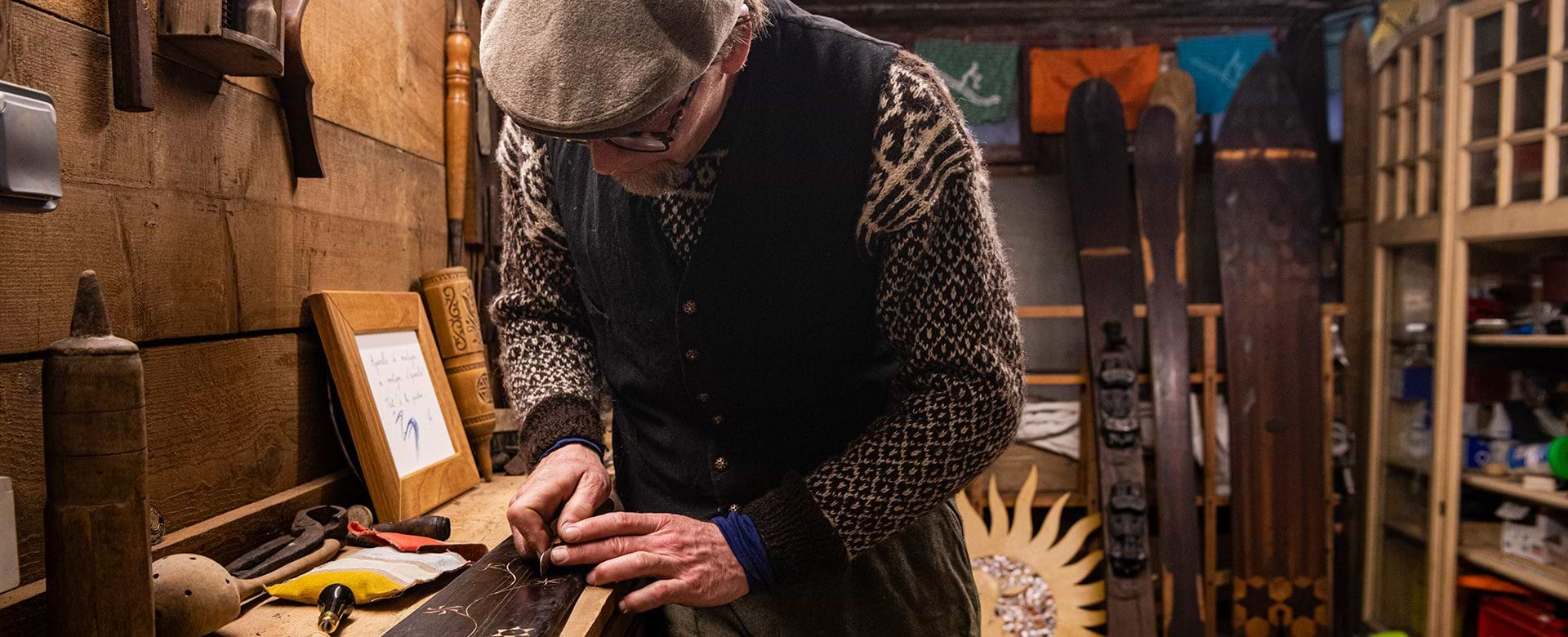Peter Steltzner appears straight out of a black-and-white postcard of nineteenth-century pioneering mountaineers. Dressed in woolen knicker boxers, a Norwegian wool cardigan, donning a classic cap and an aging pack, the American ski shaper carves untouched powder in Chamonix La Flégère with precision and style. Between turns, the artist on and off-slope passionately discusses wood core, turn radius, stiffness, and connection to the snow. Don’t be fooled by his old-school style; Steltzner is one of the most knowledgeable individuals in modern freeriding and ski shaping.
Steltzner’s skis are a remarkable balance between beauty and performance, fine art and precision tools. Peter strives to create the ultimate ski for everyone in every condition, guided by the harmony of tradition and performance while preserving passion and soul in the finished work. Every pair of skis he creates is unique.
Twelve years ago, the soft-spoken American from Sausalito, California, found his calling in Chamonix. For 20 years, he lived in Paris, where he earned his living creating handmade wooden furniture. Following his love for mountains and skiing, he jumped on the opportunity to rent a historic old water mill in Les Praz, a picturesque village on the outskirts of Chamonix. There he created his first Rabbit on the Roof skis, a name that pays homage to the colony of rabbits that dwelled on the roof of his Paris workshop.
His expression brightens when he talks about the mill. It is a part of him and he a part of it. When Steltzner and his wife, Anati Graetz, moved in, it became “le moulin des artistes” (the artists’ mill) and was a rare sanctuary for artists in the Chamonix valley. They hosted exhibitions, parties, and open houses. Above all, Peter had a workshop to craft wooden skis.
The core material is always sustainably sourced European Ash—it has natural suppleness and flexibility with a unique density that absorbs vibrations comfortably. He finishes the skis with different wood types, depending on the ski and its future owner: beech, bamboo, chestnut, cherry, rosewood, and more.
“It’s like choosing a color palette,” Steltzner explains. “After years of work as an ébéniste (master craftsman) in Paris, I’ve learned why to choose a particular wood, how I need to relate to it, how to see it, what part I should use, and what works best for a ski. Each piece of wood has a history to it.”
The most important part of his craft is the human exchange with the skier who will use the ski. Every build is a process of looking at the individual’s stature, how they ski, and what kind of skiing they like. Together the ski and skier will form a lasting relationship and grow. Steltzner is in personal contact with every user of his skis.
“People get attached to their skis,” Steltzner says. “It’s like a musician with his instrument; it becomes an extension of your body! It’s always such a pleasure when people come back and tell you how much they love their skis. Most clients are passionate skiers, they’ve been through industrial pairs, and they want to find their perfect skis. They like the concept of a beautiful object that also is technically performant.”
The iconic mill caught fire one December night in 2016. Peter Steltzner’s life works burnt down with the flames that night. The couple’s private home, their workshop, the machines, an irreplaceable collection of unique wood, the yearly production of skis awaiting delivery, Anati’s paintings, hand-crafted furniture, a collection of artist and mountain guide Andy Parkin’s artwork—all were reduced to ashes.
There was nothing the couple could do. Peter and Anati stood in shock all night, watching their whole life disappearing with the flames.
The Chamonix Valley stood in solidarity after the fire. Everyone wanted to help get the couple and their business back on their feet. Nevertheless, the process has been wrought with mental strain and moments of depression. In these moments of darkness, Steltzner turned to the place he has always felt most at peace.
“Skiing has helped me enormously to heal. It's a personal moment of pleasure when you leave all your worries behind.”
Peter is pursuing his dream for the mill to rise from the ashes and has finally found the finances and resources to rebuild his beloved workshop and home. Thanks to the community’s assistance in finding used machines and equipment, the workshop is set up again. The press required a complete restoration. When Peter ultimately managed to open the press months after the fire, a pair of unique skis inside remained intact, untouched by the flames. This unique pair of skis will be cherished as a personal treasure as Rabbit on the Roof skis will once again see the light of day.


































